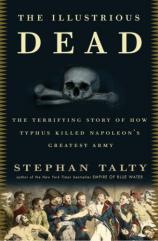The Illustrious Dead: The Terrifying Story of How Typhus Killed Napoleon's Greatest Army
Review
The Illustrious Dead: The Terrifying Story of How Typhus Killed Napoleon's Greatest Army
This is the story of an army and a microbe. The microbe
wins.
That’s a bit of an understatement, like saying that
Napoleon was somewhat short, or that Moscow gets a bit cold in the
winter, or that book reviewers tend to be too fond of lame similes.
The microbe went up against Napoleon’s Grand Army --- the
greatest assemblage of military might since antiquity --- and beat
the living whey out of it, all the way to Moscow and all the way
back.
On the surface, it looks like such a mismatch. Napoleon had put
together nearly half a million front-line troopers, many of them
hard-bitten veterans of his victorious Italian and Austrian
campaigns, and had significant cavalry and artillery to boot.
They had the best training of their times, and some of the best
generalship, and were impressively well-organized for the
pre-microchip era. And yet, the army, as grand as it was, was
beaten overwhelmingly, thoroughly and comprehensively by something
it couldn’t even see, something without a brain, nothing more
than a collection of a few strands of DNA, designed to do little
more than survive --- and kill.
To be sure, the microbe had powerful allies in its campaign to
stop the French in their drive into Russia, such as the Russian
army (or at least the rank and file of that army, considering its
poor leadership). Then there was the scorched-earth tactics that
denied provender to Napoleon’s polyglot army. There was
Napoleon’s own imperial hubris in starting the conflict in
the first place, and his failure to plan for the Russian winter or
the possibility of infectious disease. There were even other
microbes in the mix --- dysentery and the like.
All of these factors combined to bog down Napoleon’s
advance to Moscow and complicate his retreat. Stephan Talty makes
the convincing argument that it was typhus, not the winter or the
tactics or any other factor, that was the primary agent that doomed
Napoleon to defeat and eventual exile. To do this, he has to master
two difficult disciplines --- military history and epidemiology ---
and combine them, showing how one impacts the other.
For fans of military history, THE ILLUSTRIOUS DEAD contains
plenty of tactical analysis, an in-depth discussion of the battles
at Smolensk and Borodino (complete with lovely maps), stories from
the diaries of the participants, and all the attendant blood and
guts. For those on the medical side, there is a detailed treatise
on the origins and history of typhus, a fascinating account of how
the disease moves through populations, and an enlightening
discourse on what Napoleonic doctors knew (or thought they knew)
about typhus.
The combination of these two disciplines, in and of itself,
would be reason enough to read and recommend the book. But the
quality and depth of Talty’s research serve primarily to
complement the excellence of his writing. He manages the formidable
job of exposition with relative ease, but his real strength is in
the near-lyrical quality of his prose. Most good writers can write
movingly and effectively about the beautiful and the sublime; it is
Talty’s gift to bring the horrible and miserable to vivid,
compelling life. He delights in such outrages as the sacking of
Moscow, the suffering of the Grand Army on the retreat, and the
progressive horror of the onset of typhus symptoms on the
vulnerable human body. Given Talty’s talent in spinning prose
from awfulness, the story of the Grand Army and the microbe must
have been irresistible, just as THE ILLUSTRIOUS DEAD should be
irresistible for readers.
Reviewed by Curtis Edmonds, who writes the "Northbound" blog at http://www.txreviews.com/blog. on January 22, 2011
The Illustrious Dead: The Terrifying Story of How Typhus Killed Napoleon's Greatest Army
- Publication Date: June 2, 2009
- Genres: History, Nonfiction
- Hardcover: 336 pages
- Publisher: Crown
- ISBN-10: 0307394042
- ISBN-13: 9780307394040





